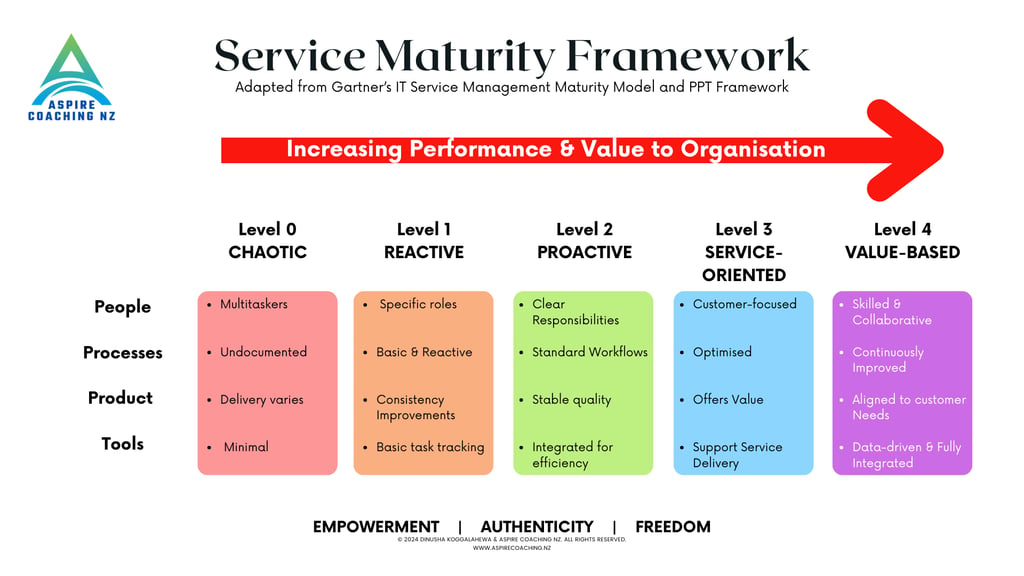Service Maturity: A Framework for Growth and Excellence
This article explores how service maturity frameworks can drive growth for small businesses. By combining Gartner's IT Service Management Maturity Model with the People, Process, Technology (PPT) framework, it outlines a pathway for businesses to enhance their service delivery and operational efficiency. Key offerings like Service Maturity Assessments, Improvement Strategies, and Coaching help businesses build structured, high-value services that align with customer needs and scale effectively over time. Perfect for business owners aiming for sustainable, strategic improvement.
SERVICES
Dinusha Koggalahewa
11/12/20243 min read


In previous articles, we explored Conscious Leadership, which empowers leaders to align values, resilience, and growth mindset to lead with authenticity and impact. We also covered Team Cohesion, highlighting strategies for creating high-performance teams through shared vision, effective communication, and a culture of trust and accountability.
This article builds on those foundations by introducing a Service Maturity framework — which presents a structured approach for small businesses to enhance service delivery and operational efficiency.
Why Service Maturity?
Service maturity is essential for small businesses aiming to optimise operations, improve customer satisfaction, and drive sustainable growth. Combining Gartner’s IT Service Management (ITSM) Maturity Model with an adapted People, Process, Technology (PPT) framework provides a comprehensive path for assessing and improving service maturity, ensuring alignment with a business’s mission and objectives.
Understanding the Service Maturity Model
In my previous career, I leveraged Gartner’s ITSM Maturity Model as a tool for improving various aspects of business operations. This model describes five progressive levels of organisational maturity:
Chaotic: Services are ad hoc and rely on individuals, with undefined processes and generalist roles.
Reactive: Processes are more structured but primarily focused on immediate, reactive needs.
Proactive: Roles become specialised, and preventive planning is introduced to reduce issues.
Service-Oriented: Operations are aligned with customer needs, and processes ensure consistent, reliable delivery.
Value-Based: Services are strategically aligned with business goals, focusing on delivering consistent, high-quality customer value.
The PPT Framework: People, Process, Technology
The PPT Framework highlights the interconnected roles of People, Process, and Technology in driving organisational improvement. Adapted for service maturity, it provides a practical structure to progressively evaluate and develop each area, recognising that as a business matures, the alignment of these elements becomes essential for operational efficiency and delivering consistent value. Here are the core areas we consider:
People: Skills, roles, and responsibilities shift from generalist to highly specialised as maturity advances.
Process: Informal workflows evolve into streamlined, data-driven processes that support consistent outcomes.
Product/Service: Quality improves from basic, variable offerings to high-value, tailored services.
Tools: Minimal tools at early stages give way to integrated, data-driven systems supporting strategic insights and efficiency.
A Framework for Small Business Service Maturity
Combining Gartner’s maturity levels with the PPT Framework components, small businesses can assess their current state of service maturity and develop a roadmap for growth:
Chaotic: Generalist roles, unstructured processes, varied product quality, minimal tools.
Reactive: Defined roles with basic workflows focused on immediate issues, consistent quality, simple tracking tools.
Proactive: Clear, specialised roles; preventive workflows; reliable product/service quality; integrated systems.
Service-Oriented: Customer-focused teams, optimised processes, quality aligned to customer needs, advanced tools.
Value-Based: Highly skilled teams with collaborative culture, outcome-focused workflows, strategic alignment, fully integrated technology.
The Benefits of Service Maturity
Advancing service maturity brings tangible benefits to small businesses, including:
Increased Efficiency: Processes are refined, reducing waste and improving productivity.
Enhanced Customer Satisfaction: Reliable, high-quality service builds client trust.
Sustainable Growth: Structured improvements support long-term business scalability.
Applying the Model: How We Help
Our approach to service maturity is tailored to your business’s unique context, using this framework to create a personalised path for growth.
Service Maturity Assessment: Baseline assessment of people, process, product/service, and tools.
Improvement Strategy Development: Strategies to drive efficiencies and align services with customer needs.
Developmental Coaching: Ongoing support to foster continuous improvement.
Operational Excellence Workshops: Training focused on best practices for enhancing service maturity.
Ready to Advance Your Service Maturity?
If you're ready to take the next step toward sustainable growth and operational excellence, contact us to schedule a service maturity assessment and start your journey toward a customer-centred, high-performing business.


In a free 30-minute call, we’ll review your unique challenges and explore practical strategies tailored to empower you, your team, and your business.
Book a Free Consultation
Legals
Disclaimer | Privacy Policy | Terms of Use | Cancellation & Refund Policy
© 2022 - 2025 Aspire Coaching NZ. All Rights Reserved
